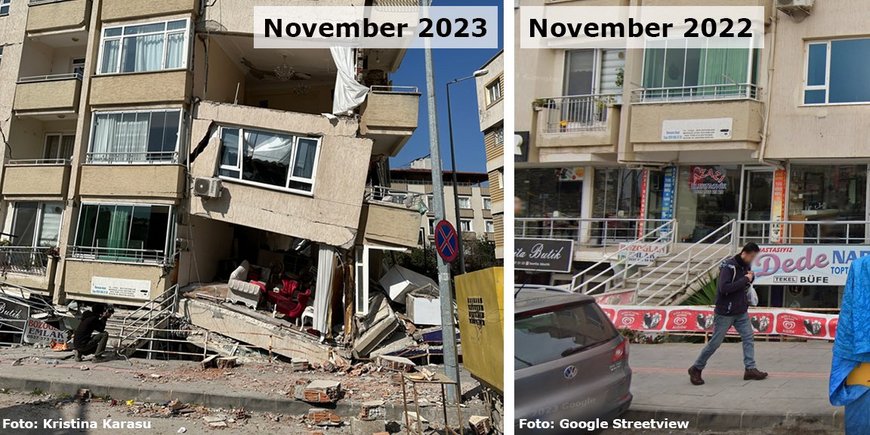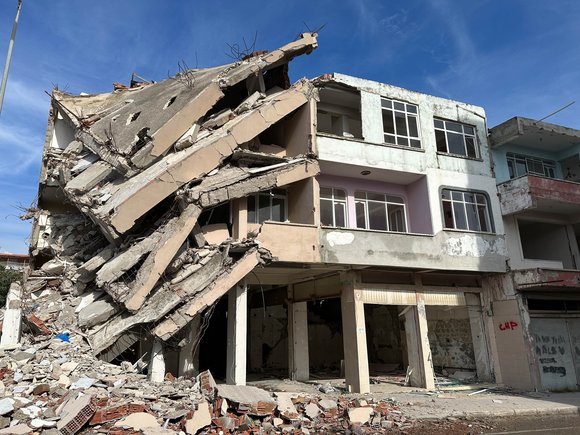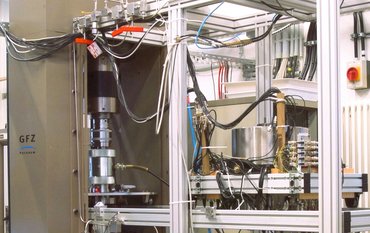The Kahramanmaraş earthquake and its consequences
On February 6th, 2023, the devastating magnitude MW 7.8 Kahramanmaraş earthquake in South East Türkiye ruptured multiple fault segments of the ‘East Anatolian Fault Zone’ separating the Anatolian and Arabian tectonic plates. This earthquake and its aftershock sequence was followed by a second large earthquake with MW 7.6 about 9 hours later and some 90 kilometres away from the epicenter of the first mainshock. Combined, the ground shaking from these powerful devastating earthquakes led to nearly 60,000 casualties, 300,000 affected buildings and about 120 billion USD financial damage.
Search for precursor phenomena for such earthquakes
Although the short-term prediction of the time, magnitude and location of future earthquakes is currently not possible, some field observations and numerous measurable parameters derived from seismic and geodetic data are currently being explored in the context of containing potential information on an incoming earthquake.
In a study now published in the journal Nature Communications seismologists around Grzegorz Kwiatek, Patricia Martínez-Garcón and Marco Bohnhoff from the GFZ German Research Centre for Geosciences Potsdam, together with colleagues from Stanford University (California, UDA), Gebze Technical University (Türkiye), and Kandilli Observatory and Earthquake Research Institute Istanbul (Türkiye) employed seismic catalogue and waveform data from regional seismic networks recorded since 2014 to study seismic processes preceding the MW 7.8 Kahramanmaraş mainshock.
Spatio-temporal analysis of regional seismicity using the latest statistical and machine learning methods
The spatio-temporal analysis of regional seismicity allowed to observe an 8-month long crustal seismicity transient suggesting a preparation process in the region around the epicenter. This highlighted the high and – more importantly – increasing seismic hazard there. The observed spatio-temporal clustering and localization of seismicity is known from controlled laboratory rock deformation experiments and has been observed for some – but by far not all – large continental earthquakes during the last decades.
Dr Grzegorz Kwiatek, lead-author of the study states: “With the goal to identify specific signatures in the seismic catalogue and waveform data from the region we employed statistical and machine-learning based data processing techniques. That allowed to identify peculiar characteristics of the seismicity observed within a radius of 50 kilometres around the mainshock starting about eight months before the earthquake”.
Seismicity clusters near the epicentre started 8 months before the main earthquake
In particular the occurrence of two transient spatio-temporal clusters of seismicity starting in June 2022 and located about 20 kilometres from the future earthquake epicenter attracted the attention of the seismologists. They represent an observable acceleration of seismic activity in the epicentre region with a significantly greater proportion of larger events with respect to the small ones.
Dr Patricia Martínez-Garzón, who led the research team of the study, emphasises: “These observations suggest a build-up of stress within the future epicentre region during the months prior to its rupture. Although other seismicity clusters were previously observed within the analysed time period (2014-2023) as far as 65 kilometres from the future earthquake epicentre, they did not display equivalent spatio-temporal and statistical properties. Comparing our observations with the findings before other recent large earthquakes in California suggests that in the future, monitoring seismicity transients may help intermediate-term earthquake forecasting systems in the future to better prepare for a big one”.
Short-term forecast still not possible
The last weeks before the Kahramanmaraş earthquake, the future mainshock epicentral area within 10 kilometres presented scarce seismic activity, as derived from the waveform data using machine learning techniques. This activity provided no evidence for the final short-term acceleration before the mainshock, as observed in the 1999 MW 7.6 Izmit earthquake in the western portion of the North Anatolian Fault.
Prof Marco Bohnhoff, head of the GFZ section “Geomechanics and Scientific Drilling” concludes: “While our observations are a key finding to better understand the processes leading to big earthquakes on the time scale of months, short-term prediction of such events remains to be a long-term goal in seismology and is currently not possible. This said, identifying hot spots for future events months before they occur gives local authorities important information at hand to improve resilience of population centres located near active faults”.
Outlook and application to Istanbul
The seismicity preceding the Kahramanmaraş earthquake show some similarities with those observed on other comparably complex and multi-segment strike-slip fault ruptures such as the 1992 MW 7.3 Landers and 2019 MW 7.1 Ridgecrest 2019 earthquakes in California. The observable trends of seismicity-derived parameters also follow those previously documented in both laboratory experiments and numerical models of complex earthquake rupture affecting multiple fault segments. However, the variability of apparent earthquake nucleation processes observed for different events, the difficulty of distinguishing preparatory processes from other deformation transients that do not lead to major earthquakes, the participation of secondary faults, and an unknown false alarm rate, all suggest that with our current state of knowledge, intermediate-term earthquake warning – if possible – still lies in seismology’s future.
The refined methods used in this study will be transferred to long-term observations in the Istanbul region with its about 20 million inhabitants where a large (M>7) earthquake is overdue. There, GFZ Potsdam is operating the borehole-based GONAF observatory aiming to reduce the observational gap between controllable laboratory experiments and uncontrollable natural earthquakes posing a huge thread to mankind.
Funding:
Dr. Martínez-Garzón is funded by the ERC Starting Grant QUAKEHUNTER (101076119). GONAF is part of the GFZ Plate Boundary Observatory initiative and was co-funded by German, Turkish and US agencies as well as from the International Continental scientific Drilling Programme ICDP that is based at GFZ Potsdam.
Original Study:
Kwiatek, G., Martínez-Garzón, P., Becker, D. et al. Months-long seismicity transients preceding the 2023 MW 7.8 Kahramanmaraş earthquake, Türkiye. Nat Commun 14, 7534 (2023). DOI: 10.1038/s41467-023-42419-8
https://www.nature.com/articles/s41467-023-42419-8














![[Translate to English:] Torsten Sachs in front of a climate station on a field](/fileadmin/_processed_/3/9/csm__TorstenSachs_bearbeitet_GS_4a1365ef84.jpeg)

![[Translate to English:] left image flood at the Ahrtal: image from above, several houses are flooded; left image:: Heidi Kreibich;](/fileadmin/_processed_/4/4/csm_Bild2_9af0130e9f.png)



![[Translate to English:] Start der Vega Rakete](/fileadmin/_processed_/6/4/csm_20231201-kachel_Vega-VV23-launch_ESA-CNES-Arianespace_706716b68c.jpeg)








![[Translate to English:] Poster exhibition at the Brandenburg Hydrogen Day at the GFZ, some participants in the foreground](/fileadmin/_processed_/6/5/csm_Erster_Brandenburgischer_Wasserstofftag_GFZ_402fcec95e.jpeg)
![[Translate to English:] Group picture of the participants](/fileadmin/_processed_/9/4/csm_20231108_CAWa-Workshop-Tashkent_Gruppenbild_99ea779d8a.jpeg)

![[Translate to English:] [Translate to English:] Hörsaal](/fileadmin/_processed_/e/6/csm_H%C3%B6rsal_e21ac645fb.jpeg)


![[Translate to English:] The Delegations in the Historic Library on the Telegrafenberg. In the back there are from left to right, the Dutch Ambassador for Germany, Ronald van Roeden, the Dutch Minister for Education, Culture and Science, Robbert Dijkgraaf and the scientific director of the GFZ, Susanne Buiter.](/fileadmin/_processed_/d/b/csm_Kachel-2_9eba4b4212.jpeg)


